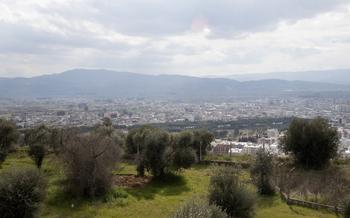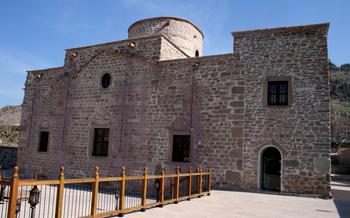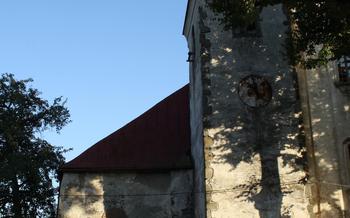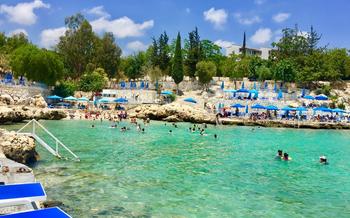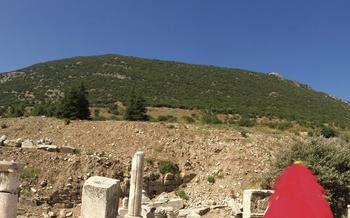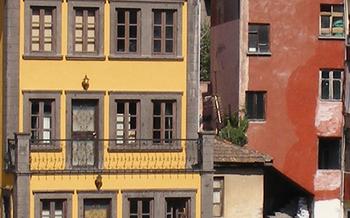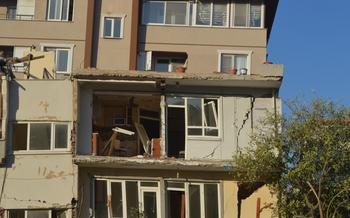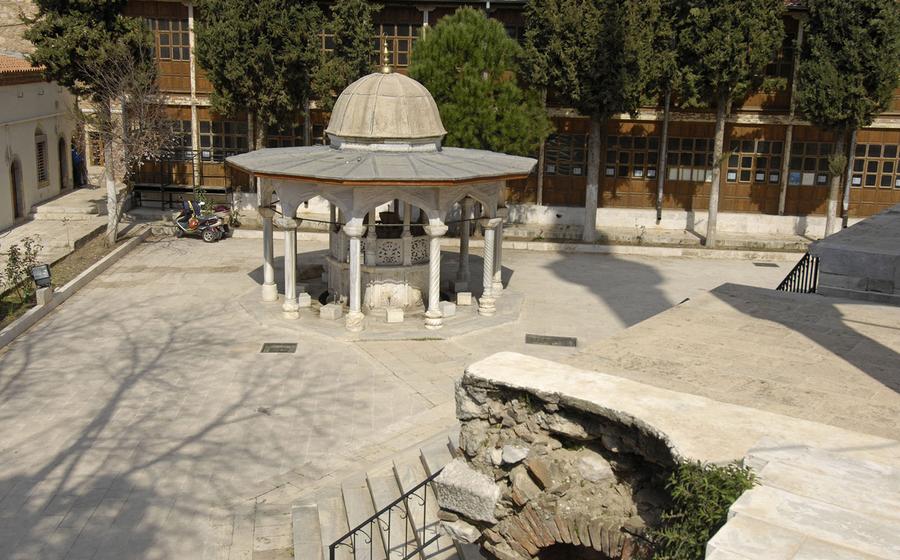
Kursunlu Monastery
- Historical Background
- Architectural Marvel
- Church of the Transfiguration
- Stunning Mosaics
- Secluded Location
- UNESCO World Heritage Site
- Restoration Efforts
- Visitor Experience
- Pilgrimage Site
- Local Crafts and Products
- Accommodation Options:
- Transportation
- Nearby Attractions:
- Insider Tip: Unveiling the Hidden Chapel
Historical Background
Journey back in time to the 11th century, when the Kursunlu Monastery, a testament to faith and devotion, was first erected. Nestled in the heart of Aydın, Turkey, the monastery has borne witness to the ebb and flow of history, serving as a sanctuary for monks and a beacon of spirituality for the faithful. Over the centuries, it has been affiliated with various civilizations, each leaving its unique imprint on the monastery's architecture and legacy. Explore the intricate tapestry of its past as you delve into the stories of the monks who once walked these hallowed grounds, shaping the religious and cultural tapestry of the region.
Architectural Marvel
The Kursunlu Monastery stands as a testament to the harmonious blend of Byzantine and Ottoman architectural influences. Constructed primarily using locally sourced stone and brick, the monastery's exterior exudes an air of solidity and strength. Its thick walls and arched entrances hint at the rich history it holds within.
Intricate carvings and decorative elements adorn the facades of the buildings, showcasing the artistic prowess of the craftsmen who worked on its construction. The monastery's central courtyard, surrounded by arcaded galleries, provides a glimpse into the daily life of the monks who once resided here.
One of the most striking features of the monastery is its impressive dome, which dominates the skyline and adds a touch of grandeur to the complex. Intricately designed windows allow natural light to flood the interior spaces, creating a sense of awe and reverence.
The overall design of the monastery reflects a deep understanding of space and functionality, with each element carefully placed to enhance the spiritual experience of its inhabitants. Visitors can't help but be captivated by the architectural beauty of this sacred site, which has stood the test of time and remains a marvel to behold.
Church of the Transfiguration
At the heart of the Kursunlu Monastery lies the awe-inspiring Church of the Transfiguration, a testament to the monastery's spiritual significance. Dedicated to the Transfiguration of Jesus, the church stands as a beacon of Byzantine artistry and devotion. Step inside, and you'll be captivated by the resplendent interior, adorned with intricate frescoes, mosaics, and iconography that narrate biblical stories and depict sacred figures. The walls come alive with vibrant colors, portraying scenes from the life of Christ, the Virgin Mary, and various saints. Gaze upon the radiant depiction of the Transfiguration, where Jesus is enveloped in a celestial light, surrounded by his disciples Peter, James, and John. The church's architecture and artwork harmoniously blend, creating an immersive spiritual experience that transports visitors to a realm of divine beauty and contemplation.
Stunning Mosaics
The Kursunlu Monastery is renowned for its exquisite mosaic artwork, which ranks among the finest examples of Byzantine art in the region. These mosaics adorn the interiors of the church, chapels, and other buildings within the complex, captivating visitors with their intricate designs, vivid colors, and profound religious symbolism.
The mosaicists employed various techniques to create these masterpieces, including opus tessellatum (small, regular-shaped tesserae) and opus vermiculatum (irregularly shaped tesserae). The subjects depicted in the mosaics range from biblical scenes and saints to decorative motifs and geometric patterns.
One of the most striking mosaics is located in the apse of the main church, depicting the Transfiguration of Jesus. The mosaic portrays Jesus standing on Mount Tabor, surrounded by the prophets Moses and Elijah, while his disciples Peter, James, and John witness the miraculous event. The radiant golden background and the expressive faces of the figures create a sense of awe and wonder.
Other notable mosaics can be found in the narthex, the side chapels, and the refectory. They depict scenes from the life of Christ, the Virgin Mary, and various saints. The attention to detail and the vibrant colors of these mosaics make them a true feast for the eyes.
The mosaics of the Kursunlu Monastery not only serve as beautiful works of art but also hold significant historical and religious value. They provide a glimpse into the beliefs, practices, and artistic traditions of the Byzantine Empire. Preserving and protecting these mosaics is of utmost importance for safeguarding our cultural heritage and ensuring that future generations can continue to appreciate their beauty and significance.
Secluded Location
Nestled amidst the serene landscapes of Aydın, the Kursunlu Monastery exudes an aura of tranquility and isolation. Surrounded by lush forests and towering mountains, the monastery's remote location adds to its allure. The journey to the site takes visitors through winding roads and picturesque villages, offering a glimpse into the region's rich natural beauty. Once you arrive at the monastery, you'll be greeted by a sense of peace and serenity that envelops the entire complex. The absence of crowds and the tranquil surroundings create an ideal environment for spiritual reflection, contemplation, and connection with nature. Whether you're seeking a respite from the hustle and bustle of everyday life or simply want to immerse yourself in the monastery's sacred atmosphere, its secluded location provides the perfect setting for a truly immersive and transformative experience.
UNESCO World Heritage Site
The Kursunlu Monastery holds a prestigious position as a UNESCO World Heritage Site, recognized for its exceptional cultural and historical significance. This designation serves as a testament to the monastery's unique architectural features, its well-preserved mosaics, and its role as a testament to the coexistence of different civilizations. UNESCO's criteria for selecting World Heritage Sites include cultural, historical, and aesthetic importance, as well as the site's authenticity and integrity. The monastery's inclusion on the list emphasizes its global significance and encourages its preservation for future generations.
Restoration Efforts
The Kursunlu Monastery has undergone extensive restoration and conservation efforts in recent years to preserve its historical integrity and ensure its accessibility to visitors. The Turkish government, in collaboration with international organizations and experts, has played a crucial role in these endeavors.
The restoration process has involved the careful repair and reconstruction of damaged structures, the conservation of priceless mosaics and frescoes, and the implementation of measures to protect the site from further deterioration. Challenges include sourcing authentic materials, addressing structural issues, and balancing the need for preservation with the desire to make the site accessible to visitors.
Despite the challenges, the restoration efforts have been successful in safeguarding the monastery's architectural and artistic heritage. Visitors can now safely explore the complex, marvel at its well-preserved features, and gain a deeper understanding of its significance in Byzantine and Ottoman history.
Visitor Experience
Visiting the Kursunlu Monastery is a unique and enriching experience that offers visitors a glimpse into the region's rich history and religious traditions. The monastery is open to the public, and visitors can explore its various areas, including the main church, the refectory, the living quarters, and the courtyard. Guided tours are available, providing visitors with in-depth insights into the monastery's history, architecture, and significance. Audio guides are also available for self-guided tours, allowing visitors to explore the site at their own pace. A visitor center provides additional information, maps, and souvenirs. The monastery's peaceful atmosphere and stunning surroundings make it an ideal place for reflection and spiritual contemplation. Visitors can wander through the grounds, admire the intricate mosaics, and soak in the serene ambiance of this ancient sanctuary.
Pilgrimage Site
The Kursunlu Monastery holds immense spiritual significance as a pilgrimage site for Christians worldwide. Believers from various denominations and cultures are drawn to this sacred place to seek solace, offer prayers, and connect with their faith. The monastery's tranquil atmosphere and rich history create a profound emotional connection for pilgrims, allowing them to reflect on their spiritual journeys and deepen their understanding of Christianity.
For many visitors, the pilgrimage to Kursunlu Monastery is a transformative experience. The opportunity to walk in the footsteps of ancient monks, touch the same stones that have stood for centuries, and immerse oneself in the monastery's spiritual energy is truly humbling. Whether seeking inner peace, divine guidance, or a deeper connection with their faith, pilgrims find solace and inspiration within these sacred walls.
The monastery's recognition as a UNESCO World Heritage Site further adds to its significance as a pilgrimage destination. This designation acknowledges the monastery's outstanding universal value and its importance in preserving the cultural heritage of Christianity. Pilgrims from around the globe are drawn to this site, eager to witness firsthand the beauty and sanctity of this ancient monastery.
Local Crafts and Products
A visit to the Kursunlu Monastery offers a unique opportunity to support the local economy and preserve traditional crafts. The surrounding villages are renowned for their skilled artisans who create beautiful handicrafts, souvenirs, and agricultural products.
-
Handicrafts: Local artisans create exquisite handmade items such as pottery, woven textiles, and intricate metalwork. These crafts are often inspired by traditional Anatolian motifs and designs, making them unique and authentic souvenirs.
-
Agricultural Products: The region surrounding the monastery is known for its fertile land and agricultural abundance. Visitors can purchase fresh fruits and vegetables, honey, olive oil, and other local delicacies directly from the farmers.
By supporting local crafts and products, visitors not only take home a piece of the region's rich culture but also contribute to the economic well-being of the community. Embrace the opportunity to connect with the locals, learn about their traditions, and savor the flavors of the region.
Accommodation Options:
To fully immerse yourself in the local culture and make the most of your visit to the Kursunlu Monastery, consider staying in the nearby villages. Several guesthouses and hotels offer a range of accommodation options to suit different budgets and preferences.
The village of Kursunlu itself has a few charming guesthouses that provide a cozy and authentic experience. These guesthouses often offer traditional Turkish breakfast and stunning views of the surrounding mountains.
For those seeking more amenities and comfort, the town of Nazilli, located just a short drive from the monastery, offers a wider selection of hotels. From budget-friendly options to luxurious resorts, there's something to cater to every traveler's needs.
Staying in the area allows you to explore the region at your own pace and discover hidden gems off the beaten path. Plus, you'll have the opportunity to interact with the local community, learn about their customs, and sample delicious regional cuisine.
Transportation
Reaching the Kursunlu Monastery requires careful planning due to its remote location. Public transportation options are limited, but visitors can take a bus from Aydın to Söke and then transfer to a local minibus that goes to the village of Kursunlu. The journey takes approximately 2 hours and 30 minutes. Visitors with private vehicles can follow the scenic mountain roads, enjoying the breathtaking views along the way. Parking is available near the monastery, but it's essential to arrive early during peak tourist season to secure a spot. Guided tours from major cities like Izmir and Kusadasi are also available, providing a hassle-free and informative experience.
Nearby Attractions:
Beyond the monastery's walls, the region offers a wealth of additional treasures waiting to be discovered. Just a stone's throw away, history buffs can delve into the ancient city of Nysa, where the ruins of a Roman theater, agora, and other impressive structures await exploration. Nature enthusiasts will find solace in the nearby Dilek Peninsula National Park, a haven of pristine beaches, lush forests, and breathtaking coastal views. For those seeking cultural immersion, the vibrant city of Aydın beckons with its bustling bazaars, traditional Turkish cuisine, and a rich tapestry of cultural heritage.
Insider Tip: Unveiling the Hidden Chapel
Beyond the main church, venture off the beaten path to discover a concealed gem within the monastery complex – the hidden chapel. Tucked away in a secluded corner, this intimate space exudes an air of serenity and mysticism. Its walls are adorned with faded frescoes, telling tales of forgotten saints and biblical narratives. As you step inside, let the silence envelop you, and allow yourself to be transported back in time, imagining the prayers and contemplations that once filled this sacred space. For a truly immersive experience, visit during the ethereal glow of dawn or dusk, when the monastery casts long shadows across the surrounding landscape.
